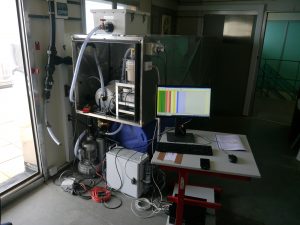Radon detector
Radon (222Rn) is a naturally occurring radioactive gas originating exclusively from the earth’s surface, with a source function typically 2–3 orders of magnitude greater from land surface than from ocean. Since it is unreactive and poorly soluble, the sole sink of atmospheric radon is radioactive decay. With its half-life of 3.8 days, radon does not accumulate in the atmosphere on timescales of longer than a month, and typical rates of vertical atmospheric mixing result in large gradients between the continental atmospheric boundary layer (ABL) and the free troposphere (FT) (Chambers et al., 2016). Thus, atmospheric radon is considered as the most reliable tracer to discriminate between the FT- and ABL-influenced air masses (Chambers et al. 2013).
PDM is equipped since 2017 with a 1500-L radon detector manufactured by the Australian public institute for nuclear sciences ANSTO. Radon volumic activity measurements made with single-filter detectors suffer from the uncertainty caused by the fate of particulate radon progeny in the natural atmosphere (especially, dry and wet deposition). The two-filter technology used in the ANSTO detector allows measurements that are free from such uncertainties and guarantee the detection of the sole ambiant gaseous radon. The high volume of the instrument (1500 L) allows to reach lower limits of detection of a few ten mBq m-3 of radon for a one-hour count.

